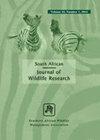Using a Relative Abundance Index to Determine Population Trends of Large Mammals in the uKhahlamba Drakensberg Park, South Africa, between 2000 and 2010
引用次数: 0
Abstract
INTRODUCTION The uKhahlamba Drakensberg Park (hereafter ‘UDP’) is a World Heritage Site in South Africa, which harbours globally significant biodiversity (UNEP/WCMC, 2011), and serves as the most important conservation area for montane habitats in southern Africa. Part of this conservation effort pertains to maintaining its complement of large mammal species, including the common eland (Tragelaphus oryx), grey rhebuck (Pelea capreolus), southern reedbuck (Redunca arundinum), mountain reedbuck (Redunca fulvorufula), oribi (Ourebia ourebi ), klipspringer (Oreotragus oreotragus), grey duiker (Sylvicapra grimmia), and Chacma baboon (Papio ursinus). Blesbok (Damaliscus pygargus phillipsi ) occur in the Drakensberg as an alien species (source for nomenclature: Kingdon, 2015). Large mammals of the UDP face several conservation challenges.We considered three key potential global environmental drivers of change in animal numbers. Firstly, the ongoing loss of habitat on adjacent land under either communal or commercial tenure that results in a reduction of the larger area available to mammals (Everson & Morris, 2006). Secondly, an apparent increase in poaching (Patel, O’Connor, Parrini & Krüger, 2019), and an expected increase in predation from black-backed jackals (Canis mesomelas) owing to the cessation of control of this species (Barnes, 2003), may both impact small antelope numbers (Rowe-Rowe, 1976; Rowe-Rowe, 1983a). Thirdly, the introduction of alien species may result in competition, all of which could reduce population numbers. Concerns based on field observations have been expressed about apparent population declines of klipspringer, mountain reedbuck, grey rhebuck, and oribi during the 1970s (Oliver, Short & Hanks, 1978; Rowe-Rowe, 1983b), but there has been no subsequent assessment of population trends. Ezemvelo KwaZulu-Natal Wildlife initiated a ranger-based census of relative abundance, but no formal assessment has been made of the information collected. The aim of this study was, therefore, to assess whether populations of the afore-mentioned herbivore species might be declining, and that of jackals might be increasing. In addition, with 58% of the baboon population in KwaZulu-Natal found in protected areas (Stone, Laffan, Curnoe, Rushworth & Herries, 2012), and the UDP serving as the most important of these, it was appropriate to assess their population trend. Furthermore, to determine the accuracy of the technique in obtaining recent and accurate population numbers to ultimately identify which species currently require conservation attention.利用相对丰度指数确定2000年至2010年南非uKhahlamba Drakensberg公园大型哺乳动物的种群趋势
简介uKhahlamba Drakensberg公园(以下简称“UDP”)是南非的世界遗产,拥有全球重要的生物多样性(UNEP/WCMC,2011),是南部非洲最重要的山地栖息地保护区。这项保护工作的一部分涉及维持其大型哺乳动物物种的补充,包括普通羚羊(Tragelaphus oryx)、灰犀鹿(Pelea capreolus)、南部苇鹿(Redunca arundinum)、山地苇鹿(Redunca fulvorufula)、奥里比(Ourebia ourebi)、klipspringer(Oreotragus Oreotragus)、灰羚羊(Sylvicapra grimmia)和Chacma狒狒(Papio ursinus)。Blesbok(Damaliscus pygargus phillipse)作为外来物种出现在Drakensberg(命名来源:Kingdon,2015)。UDP的大型哺乳动物面临着几个保护挑战。我们考虑了动物数量变化的三个潜在全球环境驱动因素。首先,在公共或商业保有权下,相邻土地上的栖息地持续丧失,导致哺乳动物可利用的更大面积减少(Everson&Morris,2006)。其次,偷猎的明显增加(Patel,O’Connor,Parrini&Krüger,2019),以及由于黑背豺(Canis mesomelas)的控制停止,预计黑背豺狼的捕食会增加(Barnes,2003),这两种情况都可能影响小羚羊的数量(Rowe-Rowe,1976;Rowe Rowe,1983a)。第三,外来物种的引入可能导致竞争,所有这些都可能减少种群数量。根据实地观察,人们对20世纪70年代克利普林格、山地芦苇、灰大黄和奥里比的明显种群数量下降表示担忧(Oliver,Short&Hanks,1978;Rowe-Rowe,1983b),但没有对种群趋势进行后续评估。Ezemvelo KwaZulu Natal Wildlife启动了一项基于护林员的相对丰度普查,但尚未对收集到的信息进行正式评估。因此,这项研究的目的是评估上述食草动物物种的数量是否正在下降,而豺的数量是否在增加。此外,夸祖鲁-纳塔尔省58%的狒狒种群分布在保护区(Stone,Laffan,Curnoe,Rushworth&Herries,2012),UDP是其中最重要的一个,因此评估其种群趋势是合适的。此外,为了确定该技术在获得最近准确的种群数量方面的准确性,以最终确定哪些物种目前需要保护。
本文章由计算机程序翻译,如有差异,请以英文原文为准。
求助全文
约1分钟内获得全文
求助全文

 求助内容:
求助内容: 应助结果提醒方式:
应助结果提醒方式:


